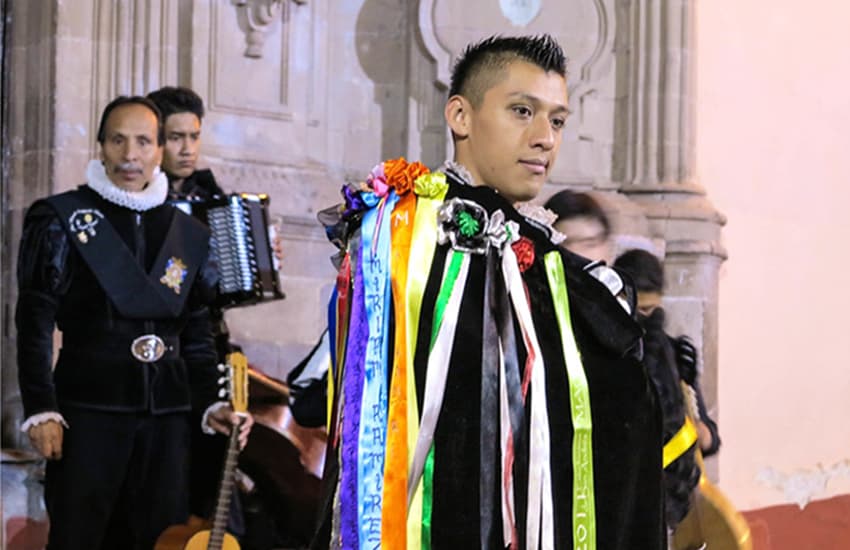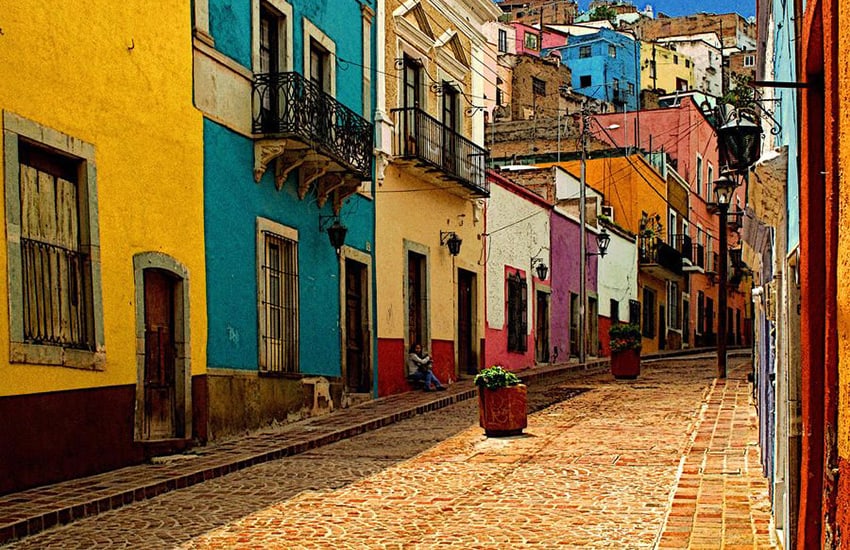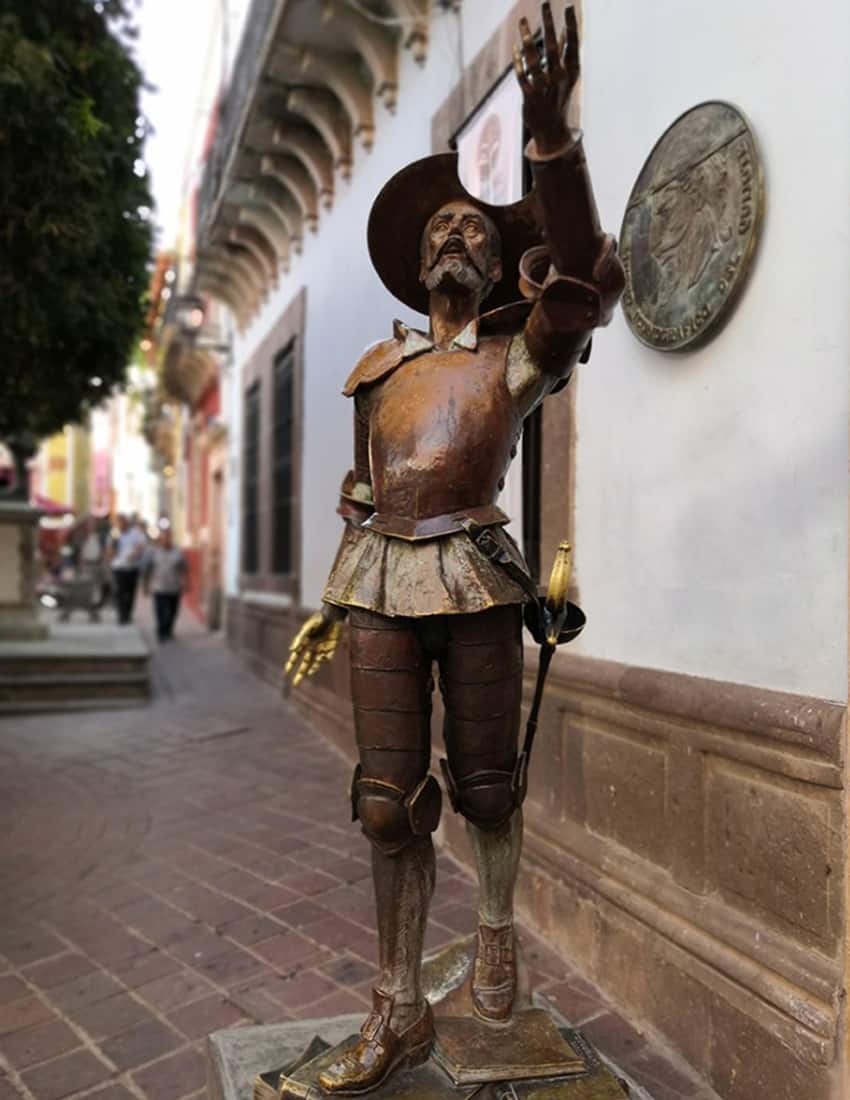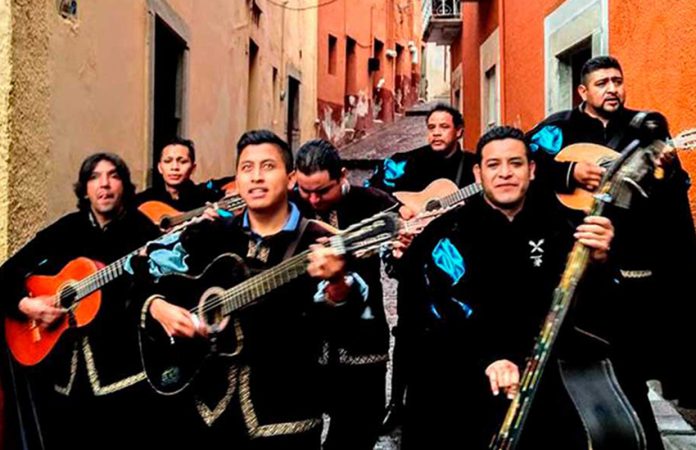As the murmurs of the day fade over the colonial curves of the tourist city of Guanajuato, the moon rises to challenge the sun’s command and a group of darkly-clad strangers prepares its nightly invasion: the bohemian estudiantinas emerge from the shadows, guitars in hand, ready to take on the night.
These roving musicians dressed proudly in regal attire that recalls the European Renaissance have prowled, plucked and chanted their way through Guanajuato’s alleyways for almost six decades. Armed with only acoustic stringed instruments and the power of their lungs, they belt out ballads recounting the tales of generations past.
They are part of the city’s fabric and reveal much of its hidden story.
In the streets surrounding the grandeur of Guanajuato’s Juárez Theater, they are hard to miss. They rove from one callejon (alleyway) to the next, wearing breeches to the knees, tights that reach up to the waist, ruffled lace shirts, and dark robes embroidered with gold.
What began in 13th-century Iberia as a way for students to earn money or something to eat was revived as a tourist attraction by the University of Guanajuato in 1963.

The tours they give, or callejoneadas as they’re known, take dozens of people on a musical waltz through some of the oldest parts of the city. Comedy is prominent in the performance: the audience is rallied to join in with the music, and the most enthusiastic are cajoled into acting out some of the city’s famous fables.
It is not uncommon for a bride and groom to hire them to tour with the wedding party and guests through the city center.
Most tours culminate in the Callejón del Beso (Alley of the Kiss), a place of Shakespearean tragedy where, according to local legend, noble-blooded Ana fell in love with the humble miner Carlos. The alleyway is so narrow that the couple’s forbidden relationship could flourish from opposing windows. Woefully, the affair was cut short when Ana’s obsessive father indicated his disapproval, meeting her heart with a dagger.
Armando Cordero, 26, came to Guanajuato to study industrial relations. He has been a proud member of the Imperial Estudiantina group for more than seven years and says that the tradition grew organically through necessity.
“The estudiantina tradition was born of students of limited means,” he said. “Guanajuato is a city of students, and there are a lot who arrive here who don’t have enough to pay for their university fees. That was true in my case, so I became an estudiantina to pay for it.”
“It’s a way of life. It taught me to feel alive, to speak to the public, to manage people, to party and to meet girls,” he explained with a smile.

Upon first glancing at an estudiantina, the casual visitor might rub their eyes and wonder how they were unknowingly transported to medieval Spain.
“This city is known as a mini-Europe; most of the architecture was copied from Europe,” local tour guide Enrique Zavala Chávez, 23, said.
Speaking from the steps of the Alhóndiga de Granaditas building, a 19th-century granary where one of the early battles for Mexico’s independence was fought, potter Gregorio Mayorga, 49, spoke proudly of the city’s European roots.
“[The Spanish] conquered us, and 90% of their customs were assimilated. There were some really good Spanish people … history tells us of many Spaniards that helped in the independence struggle,” he said.
The ringing bells of the churches, the palatial squares, the cobblestone streets all evoke an intense nostalgia. But Guanajuato doesn’t only reminisce over its days of abundant glory. The estudiantinas are an example of how the city fantasizes of a medieval world, a world that it never really knew.
It turns out those dreams go back to the very men that founded it.

The Middle Ages had already ended before Hernán Cortés planted his flag in the Aztec world, but it seems no one had told the conquistadors, who were apparently still in a nostalgic mood, dreaming of pulling up a chair at King Arthur’s Round Table. Singing from the Arthurian hymnbook and fueled by its tales of valor that heavily influenced Spanish literature of the period, they, too, were on a crusade, searching for a holy grail.
In Guanajuato, where the silver flowed, they thought they’d found it. Born of colonialism, the new city was raised to serve the Spanish Crown’s insatiable desire for minerals, and the conquistadors were driven by ideals of heroism and boyish mythologies of knights, dragons and jewels that inspired its discovery and foundation.
Guanajuato’s medieval dream inhabits not only the fictional but the physical world too. One might be fooled by the extravagant castle sitting proudly on a hill. Though convincingly primed for a Moorish invasion, its cannons have yet to be rolled out: the Santa Cecilia Hotel, which was actually built in the 1950s on the property of an old mining hacienda, longingly overlooks the city, no doubt yearning to fulfill its military duties.
And every October, the city revives a world more familiar to those conquistadors for the Cervantino arts festival. The three-week cultural binge melds opera, music, dance, theater, street performance, visual arts, film and literature, all in the name of medieval fiction. The festival has been host to some esteemed guests in search of that fantasy: Queen Elizabeth and the late Prince Phillip of England once dropped by, as did King Juan Carlos and Queen Sofía of Spain.
The Cervantino was inspired by Miguel de Cervantes, the 16th-century Spanish literary great whose masterpiece Don Quixote was published in 1605. Cervantes himself died in 1616, over 60 years before the city of Guanajuato as we know it today was founded in 1679, and over a century before its mining boom arrived in the 18th century.
In a near-perfect allegory for the Spanish imperial project, the protagonist of Don Quixote loses his senses. Blinded by romantic ideals of chivalry and knighthood, he places himself as the central hero of his own story, gallivanting, courting and proclaiming, all in the name of his nation.

An “almost-dreamed rebirth” were the words of Mexican poet Margarita Paz Paredes when she congratulated the city for reviving the works of Cervantes. Unknowingly, she had neatly described Guanajuato itself.
Amid the quiet corners of this medieval mirage, the estudiantinas have found a fitting home.
• There are 12 estudiantina groups in Guanajuato, all offering different musical tours through the city’s alleyways. The tours begin in the evening, typically departing at 8, 9 and 10 p.m. Tickets cost around 180 pesos, and vendors can be seen in their uniforms in the vicinity of Jardín de la Unión.
Mexico News Daily
